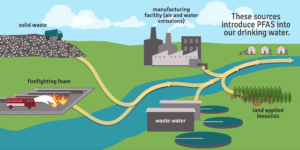What are PFAS?
PFAS are per- and polyfluoroalkyl substances that include a wide range of chemicals including GenX, PFOA, PFOS, and many others. PFAS are biopersistent, meaning they remain in organisms indefinitely without breaking down, and are bioaccumulative, meaning that over time, they build up in ever increasing amounts in people, wildlife, aquatic life, and the environment.
These “forever chemicals” are linked to increased incidence of cancer, liver and kidney disease, reproductive issues, immunodeficiencies, and hormonal disruptions. Though experts estimate that more than 200 million Americans are exposed to PFAS through drinking water, there are no binding, enforceable regulatory standards in place to protect the public and our nation’s waters from this serious health hazard.
Our Work:

CCRW’s White Oak Waterkeeper participates in Nationwide and local PFAS monitoring projects to identify PFAS contamination in the White Oak River Basin. Past projects have worked with Cyclopure, a PFAS testing lab, to assess surface water contamination and identify specific chemicals.
In 2022 CCRW was one of 113 Waterkeeper groups to participate in a nationwide report on PFAS contamination in US surface waters. Our organization worked with the Town of Maysville to determine if their known well water contamination had made its way into the surrounding White Oak River. Results of our sampling showed no detectable PFAS chemicals either upstream or downstream of the town. Only 17% of the total samples in the nationwide study had no detectable levels of PFAS.
You can read the full nationwide report here.
CCRW is continuing PFAS monitoring with other North Carolina Waterkeepers by testing other surface waters throughout the White Oak River Basin. This project will provide a more detailed assessment of PFAS contamination in North Carolina surface waters so that proper regulation of these chemicals can be pursued.
